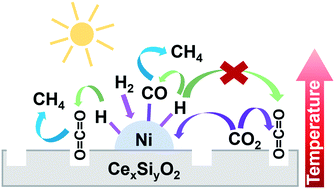Altering the influence of ceria oxygen vacancies in Ni/CexSiyO2 for photothermal CO2 methanation†
Abstract
While the benefit of CeO2 surface oxygen vacancies for CO2 methanation is well established, their role under photothermal conditions has not been probed in depth. In this work, SiO2 was systematically added to suppress the influence of CeO2 surface oxygen vacancies on the reaction. Overall, a decrease in CO2 conversion corresponded to an increase in Si composition. However, a similar level of catalytic activity was found for Ni/Ce0.9Si0.1O2 and Ni/CeO2. Unlike CeO2, Ce0.9Si0.1O2 had limited surface reducibility and restricted CO2 interaction, indicating a lack of surface oxygen vacancies. While the photothermal catalytic activities were found to be thermally driven and comparable to the reaction under thermal conditions, the light-driven reaction does not require external heating and promotes a sustainable approach for CO2 hydrogenation. Further study by in situ diffuse reflectance infrared Fourier transform spectroscopy (DRIFTS) suggested catalyst activity was dictated by the vacancies' proximity to the active Ni sites rather than their relative surface abundance. The findings provide new understanding on the role of CeO2 oxygen vacancies in catalyst performance and catalyst design for the methanation of CO2.



 Please wait while we load your content...
Please wait while we load your content...